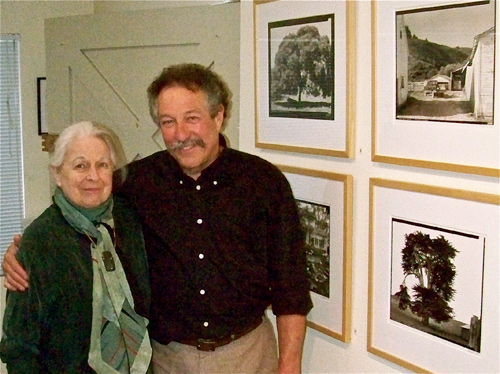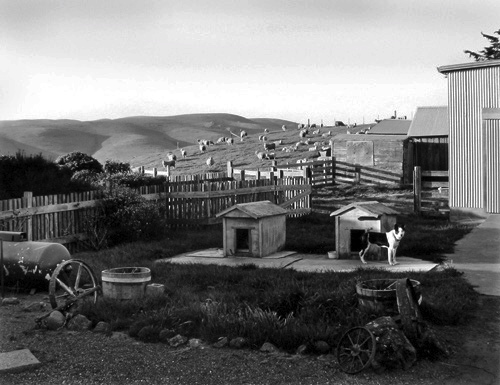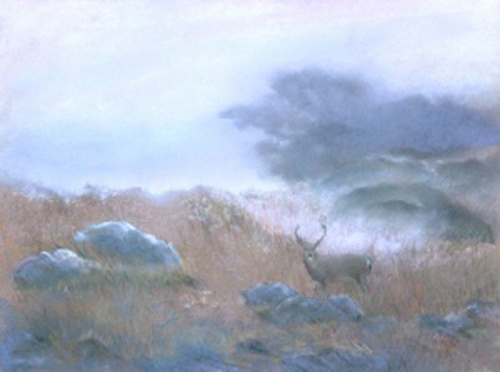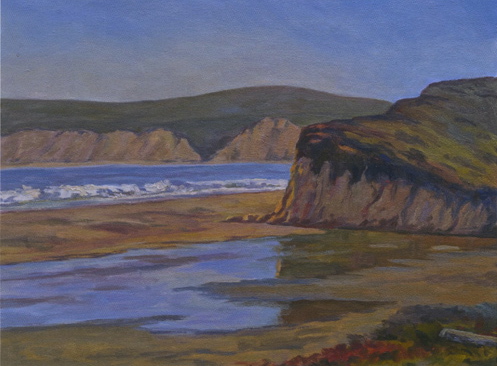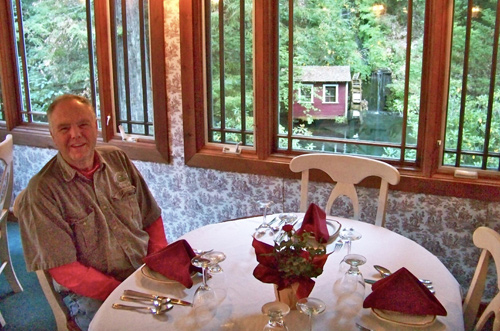I suggest you mark on your summer calendar four first-rate shows featuring people I know and admire. The venues will take you from Olema (or SFO) to Nicasio to Marshall to Cazadero.
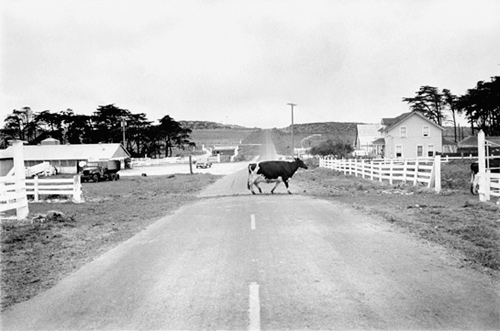
Cow Crossing Spaletta Ranch. (Photo ©Art Rogers)
Point Reyes Station photographer Art Rogers held a well-attended opening reception Saturday in the Red Barn at Point Reyes National Seashore headquarters for an exhibition titled West Marin Views.
“For more than 150 years, photographic images have told the story of the American West and an era when life was simpler,” Art wrote in announcing the show. “They highlighted the beauty and tranquility of the western frontier and captured the intimate relationship of humanity with the land and animals. But it is not just a cultural memory, it is our American identity.
“I have lived and worked in West Marin as town photographer for over 43 years. These photographs are selections from this retrospect, of places that are beautiful, tranquil, dynamic, and that connect you to humanity, the land, and animals.”

Photographer Art Rogers with Stinson Beach gallery owner Claudia Chapline.
Since 1975, Art has provided The Point Reyes Light with weekly Point Reyes Family Album portraits of families, children and babies, large groups, rural scenes, and landscapes of West Marin. He is a recipient of a Guggenheim fellowship and has also received fellowships from the National Endowment for the Arts and the Marin Arts Council, as well as the Society for the Encouragement of Contemporary Art award from the San Francisco Museum of Modern Art.
His background includes stints as a baby photographer, a photojournalist and as a teacher at the San Francisco Art Institute and Indian Valley College. His photographs are included among the collections of the San Francisco Museum of Modern Art; the International Center of Photography, New York; the Center for Creative Photography Archive, Tucson; Le Musée de l’Elysee, Switzerland; and the de Young Museum, San Francisco.
He has produced a series titled Yesterday and Today, in which the same subjects have been photographed in the same place after a time span of as much as 30 years. His portraits have documented the agricultural community on the North Coast for more than 35 years.
Art’s exhibit in the park can be seen, by appointment only, through Aug. 5. People wishing to make an appointment need to contact Annalisa Price at 663-1200 (email bookstore@ptreyes.org) or Carola DeRooy at 464-5125 (email carola_derooy@nps.gov).

Ranch Dogs at Sunset, Tomales, 2006
Those who don’t want to go to the trouble of getting reservations for Art’s exhibit at park headquarters can drop by the San Francisco International Airport museum where he has a separate exhibit titled The Rustic Landscape showing until the end of August. The museum is in Terminal 3, Level 2. _____________________________________________________________________________________
 Art by the Bay Weekend Gallery is featuring works by Chuck Eckart of Point Reyes Station on weekends through July 27.
Art by the Bay Weekend Gallery is featuring works by Chuck Eckart of Point Reyes Station on weekends through July 27.
Also on display will be art by Nancy Stein, Jude Vasconcellos and Denis Bold.
Lynn and I were there when the exhibition was unveiled Saturday. The opening reception, however, will be held from 1 to 5 p.m. Sunday, June 22.
The gallery, which is located across Highway 1 from Tony’s Seafood restaurant is open from noon to 5 p.m Saturdays and Sundays.
This abstract painting is from Chuck’s Ground Cover series, which is rarely shown in West Marin.
“The Ground Cover paintings are abstractions and inventions taken from the natural environment surrounding Point Reyes and Alice’s garden,” according to a gallery announcement. (Chuck’s wife is named Alice.)
 San Francisco Chronicle art critic Kenneth Baker has written that “Eckart (left) locates, or brings into being a focal plane where we can dwell on the pleasure of seeing paint regain the materiality it sacrifices to subject matter in most figuration.
San Francisco Chronicle art critic Kenneth Baker has written that “Eckart (left) locates, or brings into being a focal plane where we can dwell on the pleasure of seeing paint regain the materiality it sacrifices to subject matter in most figuration.
“On the same plane we experience what anyone who knows painting will recognize as real expertise.”
Chuck himself adds, “Seeing paint, especially very thick, heavy paint being moved around by various tools I find very attractive to the eye.
“As the layers build up, the richer the visual experience becomes.
“It is my chief aim to attract the eye of the viewer and hold it as long as possible. It gets the viewer to see how the picture is made.
“Very seldom does this happen when viewing realist art.”
 In addition, Chuck will exhibit a hand-produced book, Midnight Ride, which consists of 30 etchings that were created as Christmas cards during the past 50 years.
In addition, Chuck will exhibit a hand-produced book, Midnight Ride, which consists of 30 etchings that were created as Christmas cards during the past 50 years.
This etching is titled Artist’s Reflection.
___________________________________________________________________________________

Apparition, one of Nancy Stein’s pastels, is also on display at Art By The Bay Weekend Gallery. ____________________________________________________________________________________
 Oil Slick Sky by photographer Jude Vasconcellos is part of the exhibit at Art By The Bay Weekend Gallery.
Oil Slick Sky by photographer Jude Vasconcellos is part of the exhibit at Art By The Bay Weekend Gallery.
____________________________________________________________________________________

Nicasio artist Thomas Wood will hold an opening reception from 1 to 4 p.m. Saturday, June 28, and from 1 to 4 p.m. Sunday, June 29, for an exhibition titled The Cliffs of Point Reyes. A closing reception will be held from 1 to 4 p.m. Saturday, July 5. His studio, Thomas Wood Fine Art, is located on Nicasio Square.

Cliffs at Drakes Bay
“To me,” writes Thomas, “the most striking features of the Point Reyes Peninsula are the cliffs above the shoreline of Drakes Bay, where the grassy pastoral hills terminate in sheer facades, their siltstone-sandstone geology revealed by the eternally sculpting wind and weather.
“In this series, I explore the cliffs’ shapes, textures, colors, lights and shadows, from different viewpoints, as they stand sentinel over the beach and surf.
“The work was largely completed on location. I like to paint directly from nature because, if successful, I achieve a freshness and immediacy obtained no other way.” ____________________________________________________________________________________

“Shakespeare in Cazadero? Mooo!” jokes Cazsonoma Inn owner Richard Mitchell (above), mimicking radio’s old commercial for Berkeley Farms milk. “No one believed there’d be ‘farms in Berkeley’ either.” The inn’s pond and waterfall can be seen out the window.
 The stately old redwoods around Cazsonoma Inn will be hosts this summer to the Bard’s great comedy, A Midsummer Night’s Dream.
The stately old redwoods around Cazsonoma Inn will be hosts this summer to the Bard’s great comedy, A Midsummer Night’s Dream.
“With Stanford cheerleaders and Berkeley scholars chasing each other over the streams and through the woods, into romantic bliss we go,” Richard writes.
“And no one knows the way like lovable, ‘puckish’ Kate Kennedy. Kate has been directing Shakespeare in and out of Sonoma’s vineyards for 35 years, and has assembled the Avalon Players, a talented troop of local actors to relive the ‘dream’ performed 400 years ago.
“Lush sets by Ross Heil, wacky costumes by FIDM’s Renée Brimm Mitchell, produced by Pezzo Unico Productions with Castles and Concerts, featuring ‘the magic flute’ of Matt Eakle, and sponsored by Boheme Wines, Flowers Winery, Paul Mathew Vineyards, Wild Hog Vineyards, “Estero Gold” cheese, Santa Fe Sausage Company, and River Road Olive Oil. The entire illusion portends to be a night to remember.”
The audience will move between the sculpture garden in front of the inn and the waterfall beside it for different acts.
Tickets and reservations at CazSonoma Inn are available at 707 632-5255 for June 25, 26, and 27 performances (5:30 p.m. sharp). A Saturday, June 28, matinee is already sold out. Along with the performances, the $75 tickets include hors d’oeuvres and wine before the show plus a four-course dinner afterward.
Tags: Art by the Bay Weekend Gallery, Art Rogers, CazSonoma Inn, Chuck Eckart, Denis Bold, Jude Vasconcellos, Midsummer Night's Dream, Nancy Stein, Richard Mitchell, Spaletta Ranch, Thomas Wood
In 1886, West Marin became linked to the tiny town of Cazadero north of the Russian River by the North Pacific Coast Railway’s narrow-gauge line.
The first North Pacific Coast train from Sausalito had on Jan. 7, 1875, arrived in Tomales by way of the San Geronimo Valley and a depot in a cow pasture that would become Point Reyes Station; not surprisingly, the advent of train service set off construction of homes and businesses around the small depot.
By the following year, another long stretch of tracks from Tomales through Occidental (then called Howard’s) to Monte Rio had been completed.

A train of picnickers prepares to head home after partying in Cazadero in the 1890s. Photo from Narrow Gauge to the Redwoods by Bray Dickinson.
In 1876, the North Pacific Coast Railway tracks were extended west along the south bank of the Russian River from Monte Rio to Duncans Mills. There the tracks for a logging train crossed the river and doubled back upstream.
In 1886, the logging-train tracks became the first section of an extended line that ran up Austin Creek to its terminus, which the Postal Service had named Austin after the creek. The town had previously been known as Ingram’s after a hunting resort there, and resort owner Silas Ingram, who was also the postmaster, was annoyed by the feds changing the name, which had helped promote his resort.
To quote Dickinson’s book: “A United States Post Office had been established here on April 1, 1881, with Silas D. Ingram as postmaster. The name of the post office was changed [back] to Ingram’s on June 25, 1886 and on April 24, 1889 [was changed] to Cazadero.” The word is Spanish for hunting ground.
Dickinson adds, “The first regular passenger train from San Francisco arrived at Ingram’s on April 1, 1886.” The trip had begun with travelers crossing the Golden Gate on a North Pacific Coast ferry. The ferry docked in Sausalito, and the engine house for the railway was in Point Reyes Station.

The CazSonoma Inn.
In the early 1970s when I lived in Monte Rio while editing The Sebastopol Times, I frequently heard good things about the Cazanoma Lodge in nearby Cazadero but somehow never found time to check it out.
A couple of weeks ago after Lynn and I finished some maintenance on a cottage she owns in Forestville near the Russian River, she and I on a lark decided to visit Cazadero, which neither of us had seen in years.
I was still curious about the Cazanoma Lodge, so we agreed to make that part of the trip. From Highway 116, we drove up the Cazadero “Highway” in the shadow of giant redwoods until we spotted a sign beside Kidd Creek, a tributary of Austin Creek. As the sign revealed, the lodge has been renamed the CazSonoma Inn, and we drove three miles up a dirt road to reach it.

Running the inn these days are Rich Mitchell (no relation) and his wife Rene. Rich, who is seen here in the inn’s charming dining room, is a genial host. A poet and author, the innkeeper relishes literary discussions.

Lynn enjoying a snooze in our room called the Creekside.
After making reservations earlier in the week, Lynn and I drove to Cazadero Friday and checked in at the CazSonoma Inn. Our room, which included two queen-sized beds and a large bathroom, overlooked a mill pond along Kidd Creek. Including breakfast the next morning, the tab came to $150 for the night.

The mill at the bottom of a small tributary to Kidd Creek was built in 1941 but hasn’t turned for two years, Rich told us.

The innkeeper gave us some fish food, which looked a bit like dog kibble, to throw into the mill pond near a pair of old duck decoys. Each time we did, we set off a feeding frenzy of trout.

I wanted to take a photo of Rich in the inn’s pub, which overlooks the mill pond, but he insisted we trade places. (Photo by Rich Mitchell)

Raymond’s Bakery beside Cazadero Highway has become well known for excellent pastries since opening 10 years ago. By now it is a popular meeting spot for local residents. Here Lynn chooses one of the bakery’s “award-winning” oatmeal cookies.

As it happened, Lynn and I were drawn to Cazadero Friday by the bakery as well as our inn. On Friday evenings, Raymond’s sponsors music outdoors under a stand of redwoods, and we heard a fine bluegrass band called Out of the Blue. Pizza, beer, and wine were served at picnic tables. There was no cover charge. A pizza large enough for two of us cost $18.

In the center of town is the Cazadero Store, which was built in 1882. The North Pacific Coast trains used to stop out front. To the right is the town post office.

On the north end of the small downtown is the non-denominational Cazadero Community Church. Over the door hangs a sign reading: “Heavenbound Express.”

Immediately north of the Community Church is St. Colman’s Catholic Church built in 1920.

Berry’s Mill when it dominated the downtown. (Russian River Historical Society photo)
My home in Monte Rio had been built with redwood from Berry’s Mill, so I stopped a couple of times to take a look at the mill back in the 1970s when it was still sawing logs into timber in downtown Cazadero.
“The story of Berry’s Mill and Lumberyard began in 1941,” notes the mill’s website. “Twenty-year-old Loren Berry was working as a logger in the small town of Cazadero. His family had been living there since 1886 when Loren’s grandfather bought the town of Ingrams and renamed it Cazadero.
“In those days, logging was done in and near Cazadero to convert forests to grazing land. Sawmills were needed to process the logs. In 1941, with the financial backing of his father, Loren built and began operating Berry’s Mill and Lumberyard. Most of the lumber was sold to farmers.”
During World War II, “Loren left Cazadero, joined the Army, and continued building and operating sawmills in the United States, Europe, and the Pacific. At the end of the war, Loren returned to Cazadero with a new philosophy of forest preservation and management. Rather than clear-cutting and burning forests to create grazing land, Loren promoted sustained-yield cutting and replanting.”
The old mill was destroyed by fire in 1989. With the help of townspeople, the Berry family rebuilt the mill but later relocated their operation to the Russian River end of Cazadero Highway.

A turnaround for locomotives was on the north end of Cazadero, the same as in Point Reyes Station. When the railway east of Point Reyes Station was converted to standard gauge in 1920, the narrow-gauge line ran only between the two towns. Photo from Narrow Gauge to the Redwoods.

The Austin Creek disaster. Drawing by a San Francisco Examiner staff artist, from Narrow Gauge to the Redwoods.
On Jan. 14, 1894, heavy rains swelled Austin Creek to where a trestle collapsed with a train from Cazadero on it. Seven men died, including the engineer, fireman, station agent, and town postmaster. The corpse of station agent Joseph Sabine was not found for 10 days.
Writes Dickinson: “By the 10th day, everyone was ready to abandon the search as hopeless just as an elderly Spanish woodchopper asked if they would let him help. He fastened a lighted candle to a piece of board and then chanted ‘mystic’ words as he set the candle adrift.
“Some distance downstream the board circled about in an eddy, then floated up to some tangled brush. The candle went out. ‘There you will find the dead man,’ said the old Spaniard. And so it was.” Dickinson adds, “It is difficult to determine how much of this story is true. However, those who were there for years repeated the story as true.”

The Cazadero depot in 1903. Photo from Narrow Gauge to the Redwoods.
On July 31, 1933, the 7.2-mile section of narrow-gauge line that connected Cazadero and Duncans Mill closed because traffic along it had mostly disappeared. The last narrow-gauge run from Camp Meeker south to Point Reyes Station had already occurred on March 29, 1930.
After almost 45 years of contributing to each other’s well being, Point Reyes Station and Cazadero were forced to go their separate ways. Their histories, however, are forever linked. Both towns are still small, but Cazadero today bears more of a quaint resemblance to its 19th century roots.
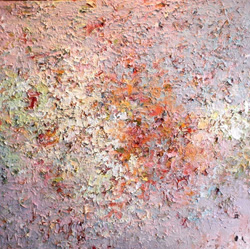 Art by the Bay Weekend Gallery is featuring works by Chuck Eckart of Point Reyes Station on weekends through July 27.
Art by the Bay Weekend Gallery is featuring works by Chuck Eckart of Point Reyes Station on weekends through July 27. San Francisco Chronicle art critic Kenneth Baker has written that “Eckart (left) locates, or brings into being a focal plane where we can dwell on the pleasure of seeing paint regain the materiality it sacrifices to subject matter in most figuration.
San Francisco Chronicle art critic Kenneth Baker has written that “Eckart (left) locates, or brings into being a focal plane where we can dwell on the pleasure of seeing paint regain the materiality it sacrifices to subject matter in most figuration.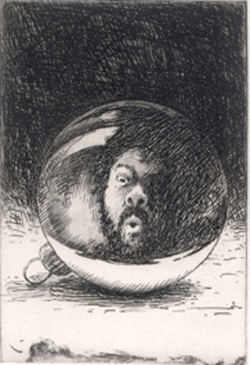 In addition, Chuck will exhibit a hand-produced book, Midnight Ride, which consists of 30 etchings that were created as Christmas cards during the past 50 years.
In addition, Chuck will exhibit a hand-produced book, Midnight Ride, which consists of 30 etchings that were created as Christmas cards during the past 50 years.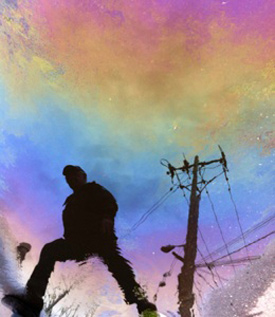 Oil Slick Sky by photographer Jude Vasconcellos is part of the exhibit at Art By The Bay Weekend Gallery.
Oil Slick Sky by photographer Jude Vasconcellos is part of the exhibit at Art By The Bay Weekend Gallery. The stately old redwoods around Cazsonoma Inn will be hosts this summer to the Bard’s great comedy, A Midsummer Night’s Dream.
The stately old redwoods around Cazsonoma Inn will be hosts this summer to the Bard’s great comedy, A Midsummer Night’s Dream.

